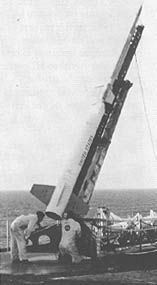നൈക്ക് അപ്പാച്ചെ
 A Nike-Apache aboard USNS Croatan | |
| കൃത്യം | സൗണ്ടിംഗ് റോക്കറ്റ് |
|---|---|
| നിർമ്മാതാവ് | എയ്റോ ലാബ്/അറ്റ്ലാന്റിക് റിസർച്ച് |
| രാജ്യം | അമേരിക്കൻ ഐക്യനാടുകൾ |
| ഒരു വിക്ഷേപണത്തിനുള്ള ചെലവ് (2024) | $6,000 USD |
| Size | |
| ഉയരം | 8.31 m (27.3 ft) |
| വ്യാസം | 4.19 m (13.7 ft) |
| ദ്രവ്യം | 760 kg (1,680 lb) |
| സ്റ്റേജുകൾ | Two |
| പേലോഡ് വാഹനശേഷി | |
| Payload to 160 km (99 mi) |
45.4 kg (100 lb) |
| വിക്ഷേപണ ചരിത്രം | |
| സ്ഥിതി | വിരമിച്ചു |
| വിക്ഷേപണത്തറകൾ | Multiple |
| മൊത്തം വിക്ഷേപണങ്ങൾ | 636 |
| ആദ്യ വിക്ഷേപണം | 17 ഫെബ്രുവരി 1961 |
| അവസാന വിക്ഷേപണം | 27 സെപ്റ്റംബർ 1978 |
| First സ്റ്റേജ് - Nike | |
| വ്യാസം | 4.19 m (13.7 ft) |
| എഞ്ചിനുകൾ | 1 x ABL M5 |
| തള്ളൽ | 217 kN (49,000 lbf) |
| Burn time | 3.5 s |
| ഇന്ധനം | solid |
| Second സ്റ്റേജ് - Apache | |
| വ്യാസം | 1.65 m (5 ft 5 in) |
| എഞ്ചിനുകൾ | 1 x Thiokol TE-307-2 |
| തള്ളൽ | 21.1 kN (4,700 lbf) |
| Burn time | 6 s |
| ഇന്ധനം | solid |
അമേരിക്കയിലെ വ്യോമസേനയ്ക്കും നാസയ്ക്കും വേണ്ടി ആദ്യം ഏയ്റോലാബും, പിന്നീട് അറ്റ്ലാന്റിക് റിസർച്ചും വികസിപ്പിച്ച രണ്ടു ഘട്ടങ്ങളുള്ള സൗണ്ടിംഗ് റോക്കറ്റ് ആയിരുന്നു അർഗോ ബി 13 എന്നറിയപ്പെട്ടിരുന്ന നൈക്ക് അപ്പാച്ചെ . 1961 നും 1978 നും ഇടയിൽ അറുനൂറിൽപരം തവണ ഈ സൗണ്ടിംഗ് റോക്കറ്റിന്റെ വിക്ഷേപണം നടന്നിട്ടുണ്ട്.
ചരിത്രം
[തിരുത്തുക]1961 ഫെബ്രുവരി 17നാണു ‘നൈക്ക്–അപ്പാഷെ’ ലോകത്ത് ആദ്യമായി വിക്ഷേപിച്ചത്. 6000 യുഎസ് ഡോളറായിരുന്നു അതിന്റെ ചെലവ്. താരതമ്യേന കുറഞ്ഞ ചെലവായതിനാൽ 17 വർഷങ്ങൾ കൊണ്ട് 636 വിക്ഷേപണങ്ങളാണു നടന്നത്. 715 കിലോഗ്രാം ഭാരമുണ്ടായിരുന്ന റോക്കറ്റിനു 30 കിലോ വരെ ഭാരം വഹിക്കാൻ (പേലോഡ്) കഴിയുമായിരുന്നു. രണ്ടു സ്റ്റേജുകളിലായി ജ്വലിക്കുന്ന നൈക്ക്–അപ്പാഷെക്ക് ഇരുന്നൂറിലധികം കിലോമീറ്റർ ഉയരത്തിലെത്താനാകും. ഇന്ത്യയിലെ ആദ്യ വിക്ഷേപണത്തിൽ ഫ്രഞ്ച് നിർമിത സോഡിയം പേലോഡിനെ 180 കിലോമീറ്റർ ഉയരത്തിൽ വിന്യസിച്ചു. കാറ്റിന്റെ ദിശ, വേഗം, വ്യാപനം, മർദം എന്നിവ കണ്ടുപിടിക്കാനായിരുന്നു ആ ദൗത്യം.[1]
ഇന്ത്യയുടെ ആദ്യ റോക്കറ്റ്
[തിരുത്തുക]1963 നവംബർ 21നു വൈകിട്ട് 6.25നു തുമ്പയിൽ നിന്ന് ഒരു അമേരിക്കൻ നിർമിത ‘നൈക്ക്–അപ്പാഷെ’ സൗണ്ടിങ് റോക്കറ്റ് ആകാശത്തേക്കു കുതിച്ചുയർന്നു. ഇന്ത്യയുടെ ആദ്യ റോക്കറ്റ് വിക്ഷേപണം. [2]
അവലംബം
[തിരുത്തുക]Citations
[തിരുത്തുക]Bibliography
[തിരുത്തുക]- Corliss, William R. (1971). NASA Sounding Rockets, 1958-1968: A Historical Summary. NASA Historical Report Series. Vol. SP-4401. Washington, D.C.: NASA Scientific and Technical Information Office. ASIN B0006C0SRW.
- Howard, David (1965). Astronautics Year: An International Astronautical and Military Space/Missile Review of 1964. Oxford, England: Pergamon Press. ASIN B01DT2D31I.
- Parsch, Andreas (22 October 2002). "USAMICOM MQR-13 BMTS". Directory of U.S. Military Rockets and Missiles. Designation-Systems. Retrieved 2017-12-07.
- Parsch, Andreas (12 July 2004). "Atlantic Research (Aerolab) Nike-Apache". Directory of U.S. Military Rockets and Missiles, Appendix 4: Undesignated Vehicles. Designation-Systems. Retrieved 2017-12-07.
- Pandey, B. K. (July–September 2010). "Space: the emerging battleground". Indian Defence Review. Vol. 25, no. 3. New Delhi: Indian Defence Review. p. 22. ISSN 0970-2512.
((cite magazine)): CS1 maint: date format (link) - Space Science Board (1966). Space Research: Directions for the Future. Washington, D.C.: National Academy of Sciences-National Research Council. ASIN B001KUTZJG.
പുറത്തേക്കുള്ള കണ്ണികൾ
[തിരുത്തുക] Nike Apache എന്ന വിഷയവുമായി ബന്ധമുള്ള കൂടുതൽ പ്രമാണങ്ങൾ (വിക്കിമീഡിയ കോമൺസിൽ)
Nike Apache എന്ന വിഷയവുമായി ബന്ധമുള്ള കൂടുതൽ പ്രമാണങ്ങൾ (വിക്കിമീഡിയ കോമൺസിൽ)
- Nike-Apache റോക്കറ്റ് പ്രകടനം handbook at നാസ ടെക്നിക്കൽ റിപ്പോർട്ട്സ് സെർവർ
- നൈക്ക് അപ്പാച്ചെ at Encyclopedia Astronautica
Text is available under the CC BY-SA 4.0 license; additional terms may apply.
Images, videos and audio are available under their respective licenses.
